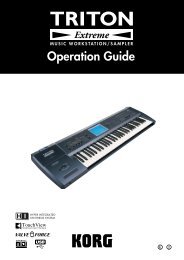PSR-E333/YPT-330 Owner's Manual - Yamaha Downloads
PSR-E333/YPT-330 Owner's Manual - Yamaha Downloads
PSR-E333/YPT-330 Owner's Manual - Yamaha Downloads
You also want an ePaper? Increase the reach of your titles
YUMPU automatically turns print PDFs into web optimized ePapers that Google loves.
Appendix<br />
Troubleshooting<br />
Problem Possible Cause and Solution<br />
When the instrument is turned on or off, a popping This is normal and indicates that the instrument is receiving electrical power.<br />
sound is temporarily produced.<br />
When using a mobile phone, noise is produced. Using a mobile phone in close proximity to the instrument may produce interference.<br />
To prevent this, turn off the mobile phone or use it further away from<br />
the instrument.<br />
There is no sound even when the keyboard is played or Check that nothing is connected to the PHONES/OUTPUT jack on the rear<br />
when a song or style is being played back.<br />
panel. When a set of headphones is plugged into this jack, no sound is output.<br />
Check the Local Control on/off setting. (See page 42 Function 028.)<br />
Not all of the voices seem to sound, or the sound seems The instrument is polyphonic up to a maximum of 32 notes — including Dual<br />
to be cut off.<br />
voice, Split Voice, auto accompaniment, song, and Metronome.<br />
Notes exceeding this limit will not sound.<br />
Playing keys in the right hand area of the keyboard does When using the Dictionary function (page 22), the keys in the right hand area<br />
not produce any sound.<br />
are used only for entering the chord root and type.<br />
The Style or Song does not play back when the [START/ Is External Clock set to ON? Make sure External Clock is set to OFF; refer to<br />
STOP] button is pressed.<br />
“Function Settings” on page 42 (Function 029).<br />
The ACMP ON indicator does not appear when the Always press the [STYLE] button first when you are going to use any Style-<br />
[ACMP ON/OFF] button is pressed.<br />
related function.<br />
Make sure that the Style Volume (page 41 Function 001) is set to an appropriate<br />
level.<br />
Is the Split Point set to an appropriate key for the chords you are playing? Set<br />
the Split Point to an appropriate key (page 41 Function 005).<br />
Is the “ACMP ON” indicator showing in the display? If it is not showing, press<br />
the [ACMP ON/OFF] button so that it does show.<br />
The Style does not sound properly.<br />
• The auto accompaniment will sometimes not change when related chords<br />
are played in sequence (e.g., some minor chords followed by the minor seventh).<br />
• Two-note fingerings will produce a chord based on the previously played<br />
chord.<br />
• Playing two same root keys in the adjacent octaves produces accompaniment<br />
based only on the root.<br />
The footswitch (for sustain) seems to produce the oppo- The polarity of the footswitch is reversed. Make sure that the footswitch plug is<br />
site effect. For example, pressing the footswitch cuts off properly connected to the SUSTAIN jack before turning on the power.<br />
the sound and releasing it sustains the sounds.<br />
The sound of the voice changes from note to note. This is normal. The AWM tone generation method uses multiple recordings<br />
(samples) of an instrument across the range of the keyboard; thus, the actual<br />
sound of the voice may be slightly different from note to note.<br />
The harmony doesn’t sound. The method of sounding the harmony effect (01–26) differs depending on the<br />
selected type. For Types 01–05, turn the Auto Accompaniment on and play it<br />
by pressing a chord in the auto accompaniment section of the keyboard, then<br />
play some keys in the right-hand side to get the harmony effect. For Types<br />
06–26, turning auto accompaniment on or off has no effect. However, it is necessary<br />
to play two notes simultaneously for Types 06–12.<br />
• The volume is too soft.<br />
• The sound quality is poor.<br />
• The rhythm stops unexpectedly or will not play.<br />
The batteries are low or dead. Replace all six batteries with completely new<br />
• The recorded data of the song, etc. does not play cor-<br />
ones, or use the optional AC adaptor.<br />
rectly.<br />
• The LCD display suddenly goes dark, and all panel<br />
settings are reset.<br />
Power suddenly and unexpectedly turns off. This is normal and the Auto Power Off function may have been activated<br />
(page 9). If you need to disable the Auto Power Off function, select “Off” in the<br />
Function settings (page 43 Function 040).<br />
<strong>PSR</strong>-<strong>E333</strong>/<strong>YPT</strong>-<strong>330</strong> Owner’s <strong>Manual</strong> 47
















